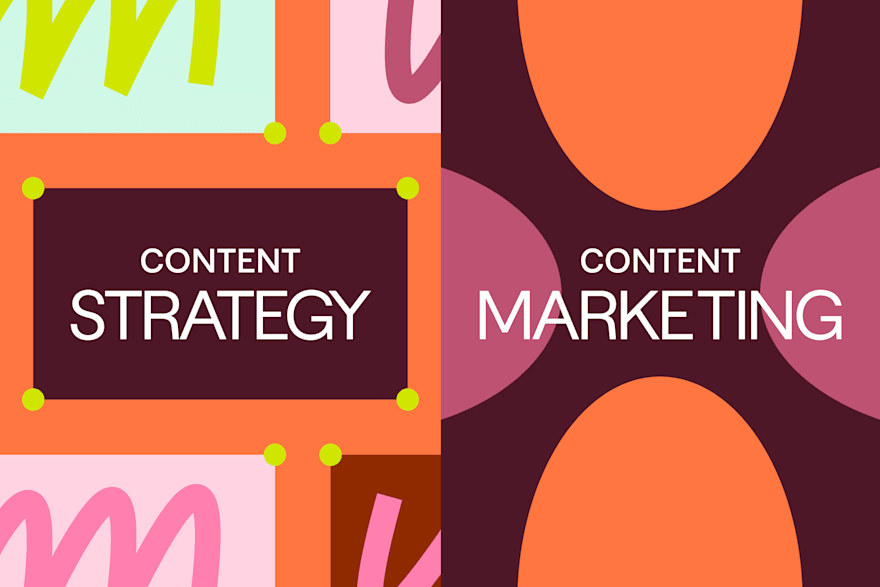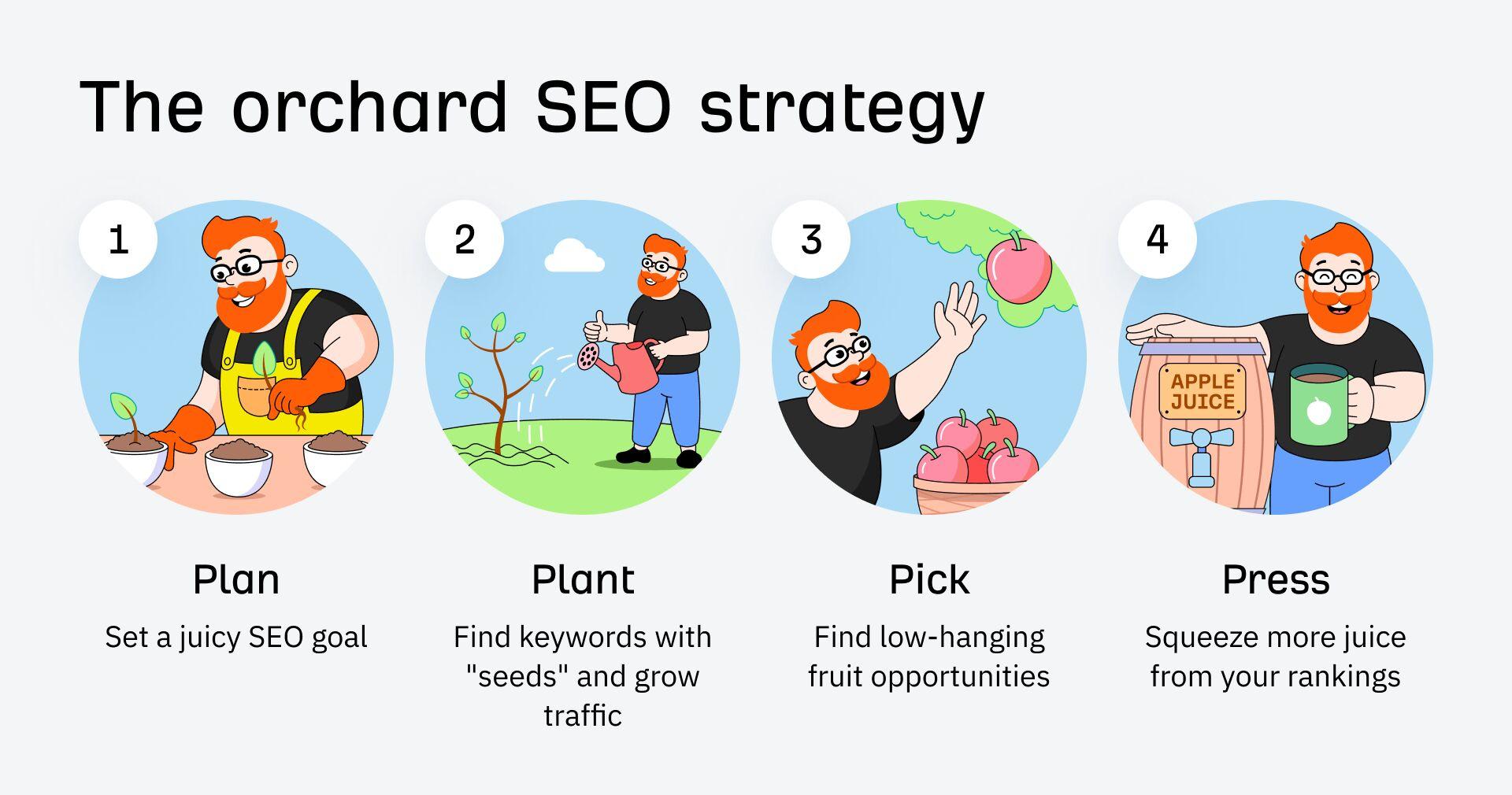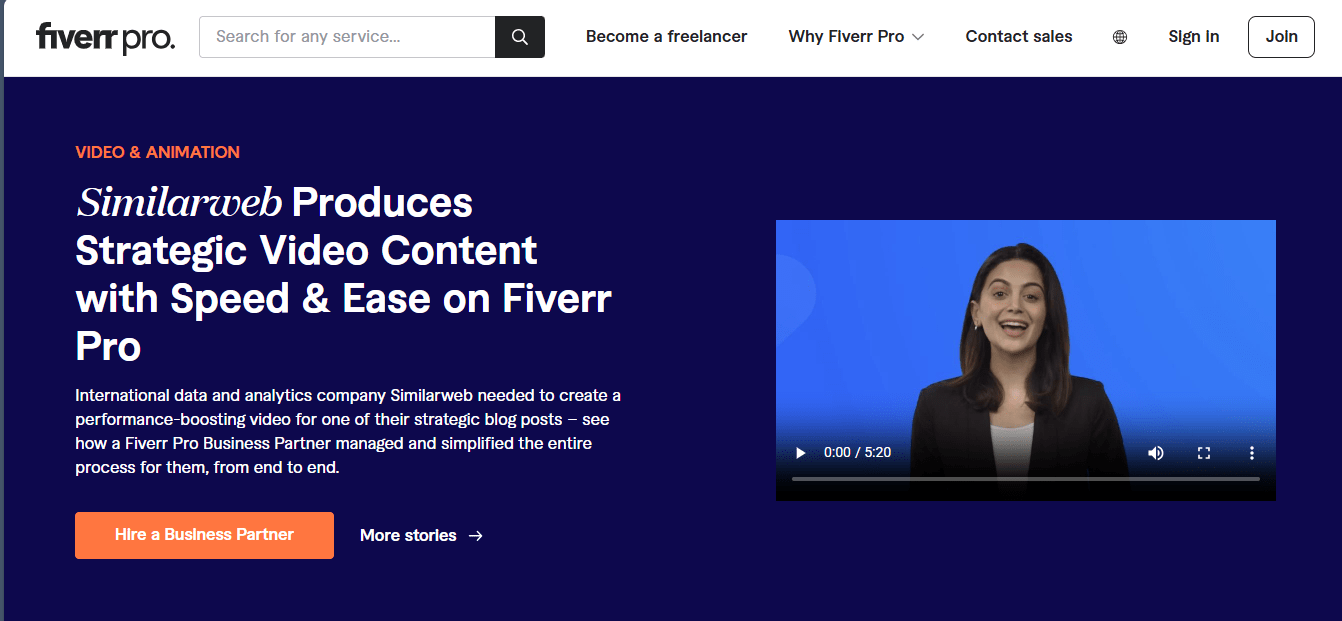Content Strategy vs. Content Marketing: Key Differences Explained
What’s the difference between content strategy and marketing? Strategy sets the framework; marketing executes the plan. Learn to build strategies, run campaigns, and grow your business with actionable tips and insights, including using Fiverr for success.
 February 28, 2025
February 28, 2025 11 minute reading
11 minute reading
As a small business owner or marketing professional, you may find yourself navigating the complexities of digital marketing. Marketing jargon like content strategy and content marketing can be confusing. You may encounter these terms as you begin to build your marketing team or work to grow your online presence. Understanding the differences between these concepts is essential for effectively generating traffic and leads for your website.
To achieve this, you must explore resources such as blogs and guides to distinguish these terms. This free online marketing guide will help you differentiate content strategy from content marketing.
What is content strategy?
Content strategy is a long-term approach that businesses use to plan, create, and manage content that aligns with their goals and engages their target market. It ensures that every piece of content serves a specific purpose—whether it’s educating, solving problems, or entertaining—while supporting your business’s overall objectives.
As Angela Proffitt and her guest Lindsay Pinchuk discuss on the GSD Diaries podcast, having an effective content strategy is important because it:
Helps attract and retain customers by delivering valuable content that drives growth.
Ensures all marketing content—like podcasts, whitepapers, and emails—works together to promote your business.
Focuses on key topics that keep your content relevant to your audience.
Guarantees brand messaging consistency to make your business more recognizable.
Allows you to easily engage with customers on social media and build a strong following.
What is content marketing?
Content marketing is a powerful tool that businesses can use to attract potential customers and retain existing ones. It focuses on understanding your audience's needs and delivering content that establishes your brand as an authority.
However, content marketing isn’t just about posting content. Successful content marketing also involves using SEO to increase visibility and analyzing performance so that your efforts lead to measurable results. With an effective content marketing strategy, small businesses can boost brand awareness, drive more website traffic, and generate leads.
What are the key differences between content strategy and content marketing?

Freepik
Content strategy and content marketing are related but distinct concepts. Here’s an in-depth look at their differences in terms of purpose, focus, tools, and metrics:
Purpose
Content strategy purpose
Establishes content's why, what, and how to align with business objectives, focusing on long-term brand positioning, customer relationships, and audience engagement. It serves as a roadmap for content creation, ensuring consistency, relevance, and strategic impact over time.
Example: Coca-Cola’s ‘Content 2020’ initiative outlined a long-term vision for storytelling across digital platforms. Rather than focusing on short-term campaigns, it emphasized brand narratives, consumer participation, and sustained engagement, guiding how Coca-Cola creates and distributes content globally.
Content marketing purpose
Clarifies the reasons for creating and sharing specific content, focusing on short-term goals such as driving traffic, generating leads, and increasing engagement. It involves executing a content plan through various formats like blogs, social media, videos, and campaigns to attract and retain an audience.
Example: Spotify’s “Wrapped” campaign encourages users to share their most played songs and playlists on social media. This annual campaign leverages personalized data storytelling to spark viral engagement, increase user retention, and drive new sign-ups—all immediate marketing wins.
Focus
Content strategy focus
This focuses on the bigger picture, identifying different types of content that best serve your target audience’s needs.
Example: Patagonia uses social marketing to cater to its eco-conscious customers. An example is their “Worn Wear” campaign, which promotes sustainability and strengthens brand trust.
Content marketing focus
This focuses on short-term marketing goals like creating a single campaign to boost sales.
Example: Coca-Cola’s “Share a Coke” campaign encouraged customers to buy personalized bottles. It generated 1.5 billion personalized bottles and over 100 million social media interactions.
Find a content marketing strategist for hire
Tools
Content strategy tools
This involves using planning tools to optimize content for the long term so that it aligns with business goals. AI-powered tools are often used to streamline this process like:
Trello: This helps teams organize content calendar and editorial calendar. With its power-ups like AutoPlan, you can generate lists, cards, and tasks for your upcoming projects.
Content audits: This reviews a business's existing content in terms of its quality, performance, and relevance. It looks at factors like SEO, engagement, and alignment with business goals. Tools like Surfer SEO help optimize and refine your content.
MarketMuse: Uses AI to analyze content gaps and suggest keyword optimizations.
Content marketing tools
It focuses on content creation and distribution to improve audience engagement and conversions. AI content marketing tools can help you personalize your content, improve audience targeting, and track performance. Examples include:
Canva: This lets companies create visually stunning content through AI features like Magic Design, which turns text into professional social posts or presentations.
SEMrush: This is an AI SEO tool that optimizes content by targeting the right keywords and monitoring search engine rankings.
Writesonic: This is an AI content writing tool that generates high-quality content—like blog posts and social media updates—based on specific prompts.
Metrics
Content strategy metrics
Metrics that are used here assess long-term success and the alignment of content with business objectives like brand positioning and audience loyalty.
Example: Lush’s “Charity Pot” campaign donates 100% of its proceeds to support causes like human rights, animal protection, and environmental conservation. This alignment with social causes resonates with customers’ values, helping build customer retention and loyalty. To measure audience loyalty, track metrics like customer retention rate, repeat purchase rate, and customer lifetime value.
Content marketing metrics
Content marketing metrics measure short-term outcomes like driving traffic, boosting conversions, and increasing sales.
Example: Dunkin’s 2024 Halloween campaign featured the Spider Donut with playful and flirtatious social media messages to engage audiences during that season. This content marketing strategy increased the brand’s social media engagement and visibility. You would track metrics like impressions, shares, and comments for this campaign to evaluate its visibility.
Why you need a content strategy and content marketing
Content strategy and content marketing are most effective when aligned. A content strategy helps you define business goals, understand the target market, and structure content. And, content marketing turns that strategy into action by delivering great content across the most effective distribution channels.
When both work together, the benefits are significant:
Consistent and cohesive content: A strong content strategy ensures consistency in brand voice across platforms, helping build trust and establish a unified identity with your audience. As Andrew Davis, a best-selling author and internationally recognized keynote speaker says, “Content builds relationships. Relationships are built on trust. Trust drives revenue.”
Efficient use of resources: A clear strategy avoids wasted efforts by directing marketing resources to content that aligns with your objectives.
Measurable impact: Content marketing provides valuable data that informs your content strategy, allowing you to assess what works and optimize future content.
For example, Shopify’s content strategy involves understanding the search intent of its audience by delivering content in various formats, like its blog posts, videos, podcasts, and guides. Their diverse website content boosts their organic search rankings and brand authority.
To align your content strategy and content marketing efforts, consider hiring a Fiverr pro to help you develop a customized content strategy and create relevant content.
How to build a content strategy
Creating a content strategy is essential to make your content marketable. As Joe Pulizzi, a content strategy and marketing expert, says, “We need to create a business strategy for our content. That means saying no to many channels and content types, and focusing on where we can build an asset, an audience, over time.”
Find a Content Strategy Expert for Hire
Here’s how to build a content strategy:
Define business goals
Establish specific, measurable, achievable, relevant, and time-bound (SMART) goals for your content. By setting SMART goals, you can evaluate your performance so that your resources and time are used effectively.
Example: To increase website traffic by 15% in six months by publishing three new blog posts weekly while improving engagement metrics like social shares.
Conduct audience research
A HubSpot survey found that 82% of marketers believe that having high-quality data about their target audience is essential for success. That’s why to achieve your business goals, you must understand your audience’s demographics, interests, pain points, and behaviors.
Here’s a step-by-step guide on how to conduct audience research:
Step 1: Define your research objectives
What do you want to learn about your audience? For example, if you’re a digital marketing agency, your research objective could be to identify what content resonates most with your audience.
Step 2: Collect quantitative data
Use analytics tools to gather measurable data on behaviors like their location, age, buying habits, and engagement. Additionally, use data capture forms to gather further information about your audience.
Step 3: Gather qualitative data
You can conduct surveys, interviews, or focus groups to gain insights into your audience’s needs and opinions.
Step 4: Analyze competitors
Study your competitors’ strengths, weaknesses, and missed opportunities to help differentiate your brand. You can do this by checking their social media, email marketing campaigns, websites, and customer reviews.
Step 5: Use tools and analytics for ongoing research
Continuously track your audience’s behaviors by using tools like Semrush’s Audience Intelligence to keep insights current.
Audit existing content
Content audits help you check how well your content is doing, identify gaps, and make sure it fits your goals and audience. Tools like Google Analytics can help make this process easier for you. If you need further assistance conducting a comprehensive audit, consider hiring Fiverr pros to help you.
Create a content plan
A content plan structures your strategy and keeps content engaging to your audiences. To create one, follow these steps:
Define your goals
Research your audience
Outline what content to produce
Schedule when to post
Post it on platforms like Facebook or TikTok
Example: If you’re promoting your brand’s skincare product, your content plan can include weekly tips on how to use the product on Instagram and daily customer testimonials in Facebook stories.
Establish metrics for success
Define the KPIs and metrics you’ll use to track progress, like monthly visits, follower count, or engagement rates.
Example: If your goal is to grow your brand’s Instagram followers, you need to monitor follower count and engagement.
How to execute content marketing effectively
After establishing your content strategy, you can now start marketing your content. Here’s how you can do this effectively:
Focus on high-quality, valuable content
According to Search Engine Journal, having high-quality content is one of the three ranking factors that influence Google’s search rankings. If you post content that doesn’t add value or provide actionable insights to your readers, your website won’t rank as high as your competitors.
As Gary Illyes from Google says, “Without content, it literally is not possible to rank. If you don’t have words on page, you’re not going to rank for it.”
To ensure that your content stays on top of search engine results pages (SERPs), it should follow Google’s E-E-A-T framework:
Experience: Shows real-life knowledge or hands-on involvement with the topic.
Expertise: Provides accurate information on the subject.
Authority: Contains information from trusted and reliable sources in the field.
Trustworthiness: It’s honest, clear, and backed by accurate sources.
If you need help optimizing your content, you can use Fiverr to connect with content experts. They can make sure your content meets Google’s standards and engages your audience.
Examples of excellent content you can publish include:
Blog posts: Informative articles that provide valuable insights on specific topics. Here’s an example of what that looks like from Pinch of Yum.

Pinch of Yum
Videos: These are engaging visual content that explains, entertains, or educates and is usually conveyed quickly. Here’s how WikiHow uses video to support its content marketing strategy:

wikiHow
Social media posts: Bite-sized content posted on Instagram, X, or LinkedIn to engage and connect with people. Here’s an example from The Content Writer Connection on LinkedIn:

Infographics: Visually appealing graphics that simplify complex data. This is how ahref’s uses infographics on its website.

Ahrefs
Case studies: Detailed reports showcasing real-life success stories achieved by using a product or service. Here’s how Fiverr uses case studies to improve its content marketing strategy:

Fiverr
Find a Content Writer for Hire
Use the right channels for your audience
To reach your audience effectively, it’s important to distribute content where they’re most active. Choosing the right distribution channels ensures that your audience sees and engages with your message.
Some channels where you can post your content include:
Website: The primary hub where you can post detailed content like blog posts or eBooks.
Email: Reach your audience directly by sending newsletters or promotions.
Social media: Communicate with your audience through platforms like Facebook.
YouTube: Post in-depth tutorials or demos about your products or services.
Podcasts: Share your thoughts and ideas with your audiences in audio format.
Optimize for SEO and discoverability
SEO helps your target audience discover your content on search engines like Google. That’s why applying SEO best practices to your content is important. Some SEO best practices—as shared in the Millionaire University podcast by Brandon Leibowitz—include:
Optimize website structure: Use clear headings, tags, and a sitemap to keep your website organized and help it rank higher on SERPs.
Conduct keyword research: Find out which words and phrases your audience is searching for and use them in your content to improve your search rankings.
Publish high-quality content: Create valuable and engaging content your audience loves. This will make your website more popular.
Build quality backlinks: Acquire high-quality backlinks from reputable and relevant websites to help improve your page’s authority and credibility.
If you’re unsure how to implement these strategies, you can use Fiverr to find help with SEO from experts who can help boost your content’s visibility.
Repurpose content for different formats
Repurposing your content allows you to create content faster, improve your search engine visibility, and boost your audience engagement. Some examples include:
Turning blog posts into videos: You can create a video summarizing key points from your popular blog posts.
Creating infographics from articles: Use statistics and data from your articles to design visual aids for your audience.
Turning podcasts into articles: Write detailed blog posts based on your podcasts or interviews.
Creating social media snippets: Break down longer content pieces and post them on social media platforms like TikTok.
Analyze performance and iterate
Analyzing the performance of your content is important to understand its effectiveness. Use analytics tools and track key metrics like traffic and conversions to help you improve your content strategy over time.
Hire content strategists on Fiverr
With Fiverr, achieving business success is within reach. Fiverr offers an easy way to find content strategists who can elevate your brand. Simply explore the platform, search for content strategy services, and choose the perfect professional for your needs.
The platform streamlines the process with helpful features such as search filters, freelancer reviews, and detailed portfolios, making it simple to find the right expert. Whether you need content plans, SEO services, or social media campaigns, Fiverr connects you with professionals ready to assist. So, hire a Fiverr freelancer to help streamline your content strategy and marketing plan today.
FAQs: Content strategy vs. content marketing
What is the main difference between content strategy and content marketing?
Content strategy focuses on planning what content to create and how it aligns with business goals. Meanwhile, content marketing is about promoting and distributing that content to engage the target audience.
Can you have content marketing without a content strategy?
Yes, but without a clear content strategy, your efforts can become disjointed, leading to inefficiency and missed opportunities. A content strategy ensures that your content marketing efforts are focused and aligned with business objectives.
How do content strategy and content marketing impact SEO?
Content strategy helps create keyword-focused content that resonates with your audience. On the other hand, content marketing ensures that your content reaches the right audience on the right channels to improve SEO rankings.
Which should come first: content strategy or content marketing?
Content strategy should come first as it defines the direction and goals of your content efforts. This is followed by content marketing, which distributes and promotes the content based on that strategy.






